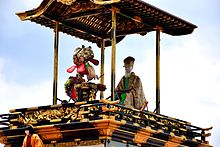Karakuri ningyō
Karakuri ningyō ( Japanese か ら く り 人形, 絡 繰 り 人形, 機関 人形 or 機巧 人形 , German "mechanical doll / marionette") are Japanese, mechanical dolls or automatons from the 18th and 19th centuries.
Most karakuri were created for entertainment purposes. Her skills ranged from shooting arrows to serving tea.
species
There are three different types of karakuri:
- Zashiki karakuri ( 座 敷 か ら く り , dt. "Reception room apparatus ") were very small and were mostly used in private settings.
- Dashi karakuri ( 山 車 か ら く り , dt. " Float apparatus ") were used for religious festivals where they portrayed ancient myths and legends.
- Butai karakuri ( 舞台 か ら く り , dt. " Stage apparatus ") were used in theaters.
Zashiki karakuri
The best-known example of a Zashiki Karakuri is shown in the picture on the right. It is a machine that serves tea. As soon as a cup of tea is placed on his hands, he rolls a certain distance set in advance by the host and moves his two little feet as if he were walking. He nods his head continuously and offers the guest the tea bowl with a bow, following the rules of the Japanese tea ceremony. The robot stops as soon as it accepts the cup. When the guest has finally drunk the bowl and placed it back on the robot's small tray, the robot rotates 180 degrees and moves back to its original starting point, where it then stops again after the host has removed the bowl.
The mechanism is controlled by a series of cams and levers and triggered by loading or unloading the hands. The weight of the cup actuates the switch through the leverage of the arms, which in turn releases the spiral spring inside, which was previously opened with a key. This then transfers the movement to the other moving parts, just like a mechanical clockwork. The feather was usually made from whalebone.
Dashi Karakuri

Dashi Karakuri are used in the traditional matsuris (festivals) of Japan. They are located on the top floor of the so-called Dashi parade floats, which can be carried around the festival area by up to 20 people. As a rule, scenes from local myths and legends are represented and performed with them. On the middle floor of the moving wagon, the mechanics are controlled by puppeteers, while on the bottom floor the performance is accompanied by musicians. The Dashi Karakuri and the moving van that went with it were considered the property of the people because they were realized through the cooperation of various local handicraft and technology specialists and, among other things, with financial and material subsidies from the population. In their splendid decoration, their technical and craftsmanship and thus their material value, they represented the cultural and technical progress as well as the prosperity of the population of their province. Accordingly, they enjoyed the reputation among the population as one of the highlights of the Matsuris of the Edo Period. They are still culturally deeply anchored in the festive tradition in many areas of Japan and are still present.
Butai Karakuri
Butai Karakuri are used for theatrical performances. Depending on how they work, the puppets are operated by one or more puppeteers in black who operate different parts of the body. The color black symbolizes that the puppeteers are not there, usually even the faces are covered so as not to distract from the puppeteers being served. Comparable to the Kabuki theater, artistic dance movements and gestures usually play a bigger role in the pieces than the spoken word and have their own symbolic language that can be specially interpreted. For these reasons, the dolls have many individual mechanisms and skills that are tailored to the performed pieces. Direct conversations between puppet characters are the exception in the karakuri pieces. The plot is mostly performed by a narrator. The Karakuri theater enjoyed great popularity, especially in the Edo period, and particularly talented puppeteers were and are still celebrated as stars in the traditionally performed plays. Nowadays, karakuri theater performances are still a popular, culturally maintained event.
Web links
- Short information about Karakuri (English)
- History of the Karakuri (English)


